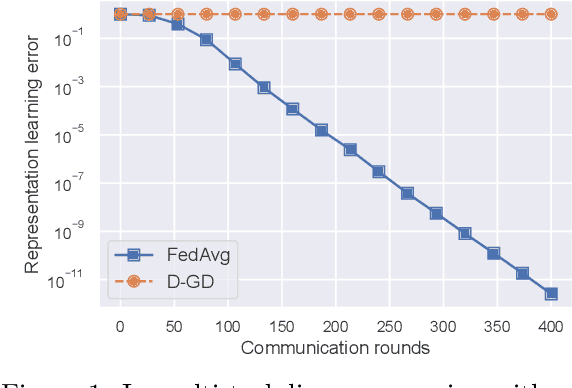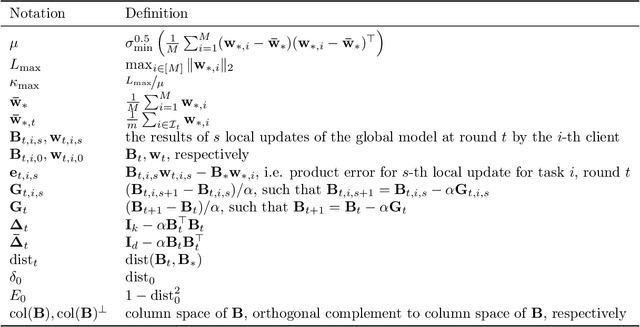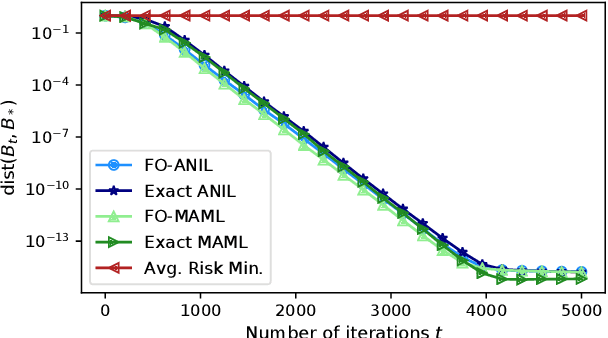Liam Collins
Revisiting Self-attention for Cross-domain Sequential Recommendation
May 27, 2025Abstract:Sequential recommendation is a popular paradigm in modern recommender systems. In particular, one challenging problem in this space is cross-domain sequential recommendation (CDSR), which aims to predict future behaviors given user interactions across multiple domains. Existing CDSR frameworks are mostly built on the self-attention transformer and seek to improve by explicitly injecting additional domain-specific components (e.g. domain-aware module blocks). While these additional components help, we argue they overlook the core self-attention module already present in the transformer, a naturally powerful tool to learn correlations among behaviors. In this work, we aim to improve the CDSR performance for simple models from a novel perspective of enhancing the self-attention. Specifically, we introduce a Pareto-optimal self-attention and formulate the cross-domain learning as a multi-objective problem, where we optimize the recommendation task while dynamically minimizing the cross-domain attention scores. Our approach automates knowledge transfer in CDSR (dubbed as AutoCDSR) -- it not only mitigates negative transfer but also encourages complementary knowledge exchange among auxiliary domains. Based on the idea, we further introduce AutoCDSR+, a more performant variant with slight additional cost. Our proposal is easy to implement and works as a plug-and-play module that can be incorporated into existing transformer-based recommenders. Besides flexibility, it is practical to deploy because it brings little extra computational overheads without heavy hyper-parameter tuning. AutoCDSR on average improves Recall@10 for SASRec and Bert4Rec by 9.8% and 16.0% and NDCG@10 by 12.0% and 16.7%, respectively. Code is available at https://github.com/snap-research/AutoCDSR.
Learning Universal User Representations Leveraging Cross-domain User Intent at Snapchat
Apr 30, 2025Abstract:The development of powerful user representations is a key factor in the success of recommender systems (RecSys). Online platforms employ a range of RecSys techniques to personalize user experience across diverse in-app surfaces. User representations are often learned individually through user's historical interactions within each surface and user representations across different surfaces can be shared post-hoc as auxiliary features or additional retrieval sources. While effective, such schemes cannot directly encode collaborative filtering signals across different surfaces, hindering its capacity to discover complex relationships between user behaviors and preferences across the whole platform. To bridge this gap at Snapchat, we seek to conduct universal user modeling (UUM) across different in-app surfaces, learning general-purpose user representations which encode behaviors across surfaces. Instead of replacing domain-specific representations, UUM representations capture cross-domain trends, enriching existing representations with complementary information. This work discusses our efforts in developing initial UUM versions, practical challenges, technical choices and modeling and research directions with promising offline performance. Following successful A/B testing, UUM representations have been launched in production, powering multiple use cases and demonstrating their value. UUM embedding has been incorporated into (i) Long-form Video embedding-based retrieval, leading to 2.78% increase in Long-form Video Open Rate, (ii) Long-form Video L2 ranking, with 19.2% increase in Long-form Video View Time sum, (iii) Lens L2 ranking, leading to 1.76% increase in Lens play time, and (iv) Notification L2 ranking, with 0.87% increase in Notification Open Rate.
A Bi-channel Aided Stitching of Atomic Force Microscopy Images
Mar 11, 2025Abstract:Microscopy is an essential tool in scientific research, enabling the visualization of structures at micro- and nanoscale resolutions. However, the field of microscopy often encounters limitations in field-of-view (FOV), restricting the amount of sample that can be imaged in a single capture. To overcome this limitation, image stitching techniques have been developed to seamlessly merge multiple overlapping images into a single, high-resolution composite. The images collected from microscope need to be optimally stitched before accurate physical information can be extracted from post analysis. However, the existing stitching tools either struggle to stitch images together when the microscopy images are feature sparse or cannot address all the transformations of images. To address these issues, we propose a bi-channel aided feature-based image stitching method and demonstrate its use on AFM generated biofilm images. The topographical channel image of AFM data captures the morphological details of the sample, and a stitched topographical image is desired for researchers. We utilize the amplitude channel of AFM data to maximize the matching features and to estimate the position of the original topographical images and show that the proposed bi-channel aided stitching method outperforms the traditional stitching approach. Furthermore, we found that the differentiation of the topographical images along the x-axis provides similar feature information to the amplitude channel image, which generalizes our approach when the amplitude images are not available. Here we demonstrated the application on AFM, but similar approaches could be employed of optical microscopy with brightfield and fluorescence channels. We believe this proposed workflow will benefit the experimentalist to avoid erroneous analysis and discovery due to incorrect stitching.
Meta-Learning Adaptable Foundation Models
Oct 29, 2024Abstract:The power of foundation models (FMs) lies in their capacity to learn highly expressive representations that can be adapted to a broad spectrum of tasks. However, these pretrained models require multiple stages of fine-tuning to become effective for downstream applications. Conventionally, the model is first retrained on the aggregate of a diverse set of tasks of interest and then adapted to specific low-resource downstream tasks by utilizing a parameter-efficient fine-tuning (PEFT) scheme. While this two-phase procedure seems reasonable, the independence of the retraining and fine-tuning phases causes a major issue, as there is no guarantee the retrained model will achieve good performance post-fine-tuning. To explicitly address this issue, we introduce a meta-learning framework infused with PEFT in this intermediate retraining stage to learn a model that can be easily adapted to unseen tasks. For our theoretical results, we focus on linear models using low-rank adaptations. In this setting, we demonstrate the suboptimality of standard retraining for finding an adaptable set of parameters. Further, we prove that our method recovers the optimally adaptable parameters. We then apply these theoretical insights to retraining the RoBERTa model to predict the continuation of conversations between different personas within the ConvAI2 dataset. Empirically, we observe significant performance benefits using our proposed meta-learning scheme during retraining relative to the conventional approach.
In-Context Learning with Transformers: Softmax Attention Adapts to Function Lipschitzness
Feb 18, 2024



Abstract:A striking property of transformers is their ability to perform in-context learning (ICL), a machine learning framework in which the learner is presented with a novel context during inference implicitly through some data, and tasked with making a prediction in that context. As such that learner must adapt to the context without additional training. We explore the role of softmax attention in an ICL setting where each context encodes a regression task. We show that an attention unit learns a window that it uses to implement a nearest-neighbors predictor adapted to the landscape of the pretraining tasks. Specifically, we show that this window widens with decreasing Lipschitzness and increasing label noise in the pretraining tasks. We also show that on low-rank, linear problems, the attention unit learns to project onto the appropriate subspace before inference. Further, we show that this adaptivity relies crucially on the softmax activation and thus cannot be replicated by the linear activation often studied in prior theoretical analyses.
Profit: Benchmarking Personalization and Robustness Trade-off in Federated Prompt Tuning
Oct 06, 2023Abstract:In many applications of federated learning (FL), clients desire models that are personalized using their local data, yet are also robust in the sense that they retain general global knowledge. However, the presence of data heterogeneity across clients induces a fundamental trade-off between personalization (i.e., adaptation to a local distribution) and robustness (i.e., not forgetting previously learned general knowledge). It is critical to understand how to navigate this personalization vs robustness trade-off when designing federated systems, which are increasingly moving towards a paradigm of fine-tuning large foundation models. Due to limited computational and communication capabilities in most federated settings, this foundation model fine-tuning must be done using parameter-efficient fine-tuning (PEFT) approaches. While some recent work has studied federated approaches to PEFT, the personalization vs robustness trade-off of federated PEFT has been largely unexplored. In this work, we take a step towards bridging this gap by benchmarking fundamental FL algorithms -- FedAvg and FedSGD plus personalization (via client local fine-tuning) -- applied to one of the most ubiquitous PEFT approaches to large language models (LLMs) -- prompt tuning -- in a multitude of hyperparameter settings under varying levels of data heterogeneity. Our results show that federated-trained prompts can be surprisingly robust when using a small learning rate with many local epochs for personalization, especially when using an adaptive optimizer as the client optimizer during federated training. We also demonstrate that simple approaches such as adding regularization and interpolating two prompts are effective in improving the personalization vs robustness trade-off in computation-limited settings with few local updates allowed for personalization.
Provable Multi-Task Representation Learning by Two-Layer ReLU Neural Networks
Jul 17, 2023Abstract:Feature learning, i.e. extracting meaningful representations of data, is quintessential to the practical success of neural networks trained with gradient descent, yet it is notoriously difficult to explain how and why it occurs. Recent theoretical studies have shown that shallow neural networks optimized on a single task with gradient-based methods can learn meaningful features, extending our understanding beyond the neural tangent kernel or random feature regime in which negligible feature learning occurs. But in practice, neural networks are increasingly often trained on {\em many} tasks simultaneously with differing loss functions, and these prior analyses do not generalize to such settings. In the multi-task learning setting, a variety of studies have shown effective feature learning by simple linear models. However, multi-task learning via {\em nonlinear} models, arguably the most common learning paradigm in practice, remains largely mysterious. In this work, we present the first results proving feature learning occurs in a multi-task setting with a nonlinear model. We show that when the tasks are binary classification problems with labels depending on only $r$ directions within the ambient $d\gg r$-dimensional input space, executing a simple gradient-based multitask learning algorithm on a two-layer ReLU neural network learns the ground-truth $r$ directions. In particular, any downstream task on the $r$ ground-truth coordinates can be solved by learning a linear classifier with sample and neuron complexity independent of the ambient dimension $d$, while a random feature model requires exponential complexity in $d$ for such a guarantee.
InfoNCE Loss Provably Learns Cluster-Preserving Representations
Feb 15, 2023

Abstract:The goal of contrasting learning is to learn a representation that preserves underlying clusters by keeping samples with similar content, e.g. the ``dogness'' of a dog, close to each other in the space generated by the representation. A common and successful approach for tackling this unsupervised learning problem is minimizing the InfoNCE loss associated with the training samples, where each sample is associated with their augmentations (positive samples such as rotation, crop) and a batch of negative samples (unrelated samples). To the best of our knowledge, it was unanswered if the representation learned by minimizing the InfoNCE loss preserves the underlying data clusters, as it only promotes learning a representation that is faithful to augmentations, i.e., an image and its augmentations have the same representation. Our main result is to show that the representation learned by InfoNCE with a finite number of negative samples is also consistent with respect to clusters in the data, under the condition that the augmentation sets within clusters may be non-overlapping but are close and intertwined, relative to the complexity of the learning function class.
FedAvg with Fine Tuning: Local Updates Lead to Representation Learning
May 27, 2022



Abstract:The Federated Averaging (FedAvg) algorithm, which consists of alternating between a few local stochastic gradient updates at client nodes, followed by a model averaging update at the server, is perhaps the most commonly used method in Federated Learning. Notwithstanding its simplicity, several empirical studies have illustrated that the output model of FedAvg, after a few fine-tuning steps, leads to a model that generalizes well to new unseen tasks. This surprising performance of such a simple method, however, is not fully understood from a theoretical point of view. In this paper, we formally investigate this phenomenon in the multi-task linear representation setting. We show that the reason behind generalizability of the FedAvg's output is its power in learning the common data representation among the clients' tasks, by leveraging the diversity among client data distributions via local updates. We formally establish the iteration complexity required by the clients for proving such result in the setting where the underlying shared representation is a linear map. To the best of our knowledge, this is the first such result for any setting. We also provide empirical evidence demonstrating FedAvg's representation learning ability in federated image classification with heterogeneous data.
MAML and ANIL Provably Learn Representations
Feb 07, 2022


Abstract:Recent empirical evidence has driven conventional wisdom to believe that gradient-based meta-learning (GBML) methods perform well at few-shot learning because they learn an expressive data representation that is shared across tasks. However, the mechanics of GBML have remained largely mysterious from a theoretical perspective. In this paper, we prove that two well-known GBML methods, MAML and ANIL, as well as their first-order approximations, are capable of learning common representation among a set of given tasks. Specifically, in the well-known multi-task linear representation learning setting, they are able to recover the ground-truth representation at an exponentially fast rate. Moreover, our analysis illuminates that the driving force causing MAML and ANIL to recover the underlying representation is that they adapt the final layer of their model, which harnesses the underlying task diversity to improve the representation in all directions of interest. To the best of our knowledge, these are the first results to show that MAML and/or ANIL learn expressive representations and to rigorously explain why they do so.
 Add to Chrome
Add to Chrome Add to Firefox
Add to Firefox Add to Edge
Add to Edge